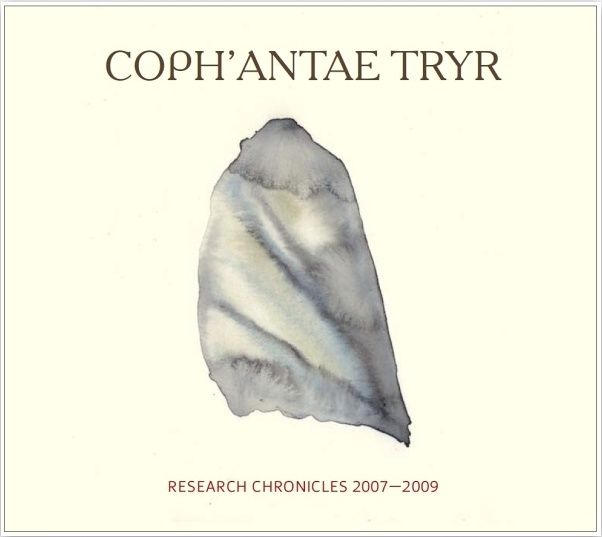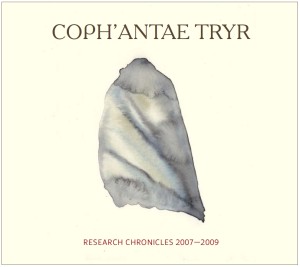Coph’antae Tryr is the project of Russian-born sound artist Guram Torua, who hails from the city of Kaliningrad in the Russian exclave of Kaliningrad Oblast. Positioned on the Baltic Sea and cut off from its mainland by Lithuania to its North and East, as well as Poland to its South, this area is rich in history, having survived German occupation through the late 1800′s / early 1900′s as East Prussia up until its split into Poland and the Soviet Union after World war II. However, Research Chronicles 2007-2009 is a very personal and spiritual journey that goes far beyond the historical senses and into something that transcends the physical plane in which we live. The collection itself has been described as “(sic) a way of enlightenment and clearing by injections of medical enzymes into the subconscious to study and learn other, undercover, dark corners of a universe and places that are simply impossible to get to physically.” Thus, delving into the past and present of mankind’s small role on this Planet and his endeavors on a geographical basis is, frankly, redundant, so I’ll abandon my usual way of introduction.
With “Research Chronicles”, Torua, through the very definition of Coph’antae Tryr, appears at first to be hinting at a medically forced astral projection of his own consciousness into the universe to be among his ancestral heritage. Rich and complex sounds team up endlessly throughout each of the four releases found on these two discs to piece together the fabric of space-time in which his spirit travels on these journeys. The name Coph’antae Tryr is fairly hard to decode, with HORUS CyclicDaemon simply breaking it down as: “Where Coph is the axe of clearing opening a window to light, „Lux resplendens“ (dazzling Light), Antae – a barrier constraining consciousness and a body, and Tryr – a medicine.” A more critical eye and research only make understanding the phrase more difficult. Tryr is the abbreviation for Trypanothione Reductase, an enzyme that few outside of the realm of enzymology would know much about, but has been described as “a genetically validated drug target in the parasite Trypanosoma brucei, the causative agent of human African trypanosomiasis,” (1) which is also known as “Sleeping Sickness” (2). The only reference I have to Coph personally is the reference to “Coph Nia” in Aleister Crowley’s “The Book of Law”, however the artist describes it as a mythical axe and through research I haven’t been able to clarify the origin of this term in that context. Antae is referred to here as “an architectural term describing the posts or pillars on either side of a doorway or entrance of a Greek temple – the slightly projecting piers which terminate the walls of the naos.” (3) Strangely enough, my initial thoughts were perhaps that the artist himself was a descendent of the Antae tribe in Slavic-Iranian history, a people who lived North of the Black Sea in the area of Ukraine and Moldova, which wouldn’t be far off from where the artist lives today. This would of course change the entire meaning of the name and was, ultimately, incorrect. No, indeed Coph’antae Tryr is a simple medically-induced opening to a place that the conscious mind isn’t prepared or capable of being.
 The complexity of the album doesn’t stop with the name of the project, however. After all, Research Chronicles is exactly that, a work of various research that is implied by the project name that took place over a two year period. Each track is strangely accompanied with the recording date as well as a very brief explanation on what type of imagery the track should create out of the imagination of the listener, so even from the very beginning, the power of suggestion is working its course. We’re led through various corridors of a fog-enshrouded world where gravity is no long a force, a place where your spirit can simply ascend to the heights of the universe’s farthest reaches. Tracks like Nerva have lush synth layers and gentle droning wood flute sounds can be so warm and inviting in places that they reflect the very essence of these spiritual journeys. You find yourself in space caught between the scientific mind of using medicine to arrive at this point that takes a spiritual mind, holding the singularity that was once the universe in the palm of your open hand.
The complexity of the album doesn’t stop with the name of the project, however. After all, Research Chronicles is exactly that, a work of various research that is implied by the project name that took place over a two year period. Each track is strangely accompanied with the recording date as well as a very brief explanation on what type of imagery the track should create out of the imagination of the listener, so even from the very beginning, the power of suggestion is working its course. We’re led through various corridors of a fog-enshrouded world where gravity is no long a force, a place where your spirit can simply ascend to the heights of the universe’s farthest reaches. Tracks like Nerva have lush synth layers and gentle droning wood flute sounds can be so warm and inviting in places that they reflect the very essence of these spiritual journeys. You find yourself in space caught between the scientific mind of using medicine to arrive at this point that takes a spiritual mind, holding the singularity that was once the universe in the palm of your open hand.
The second half of the record is slightly more abrasive, featuring some very mild noise tendencies with fuzzed out, foreboding repeating melodies and hard beats. In addition it becomes clear that there is more than simple synth ambiance and field recordings being utilized for the sound on this collection as “Mor’dall” utilizes the recording sound of the pulse of a very specific type of pulsating star, a Cepheide, though which cepheide class and star name is unknown. The following track, “Mephala”, is described as the gradual distortion of a parallax. A parallax can be defined in several ways, but in this instance it almost assuredly is being used as the means of measuring distances to celestial objects in astronomy. Thus, the distortion being caused by atmosphere, distant transparent gaseous clouds or any other number of cosmic phenomena. These points simply hammer home the fact that this isn’t an ordinary artistic means of expression, but rather a very thoroughly thought out, scientific and yet intimate work of art.
Despite the title explanations, much of the four releases seem largely sea-based in sound, with constant purling tones being the forefront factor through each release. The sounds don’t hit you like a wall, but rather wash over you and retract, only to return shortly. It seems that even field recordings of the tide were used in tracks like “Nerva”. Coph’antae Tryr explains that this quality has purpose as he has lived by the sea for most of his life, and being away from it in his travels affects his mood in a negative manner, which is the only time he actually writes music. I had also mentioned earlier that if “antae” in the project name spoke of the actual East European tribe, it would make the album take on a completely new meaning. There are several tracks throughout the collection that literally breathe of this ancestral connection. Tracks like “Sadii”, explained as “Galaxy of the Lost the Way Splinters” are beyond impressive in their ability to conjure up images of astrally projecting yourself into cosmic meeting place with your lineage. The whole experience mocks the visions one might assume a Mayan village elder had during a bloodletting ritual involving the usage of stingray spines. So, at least subconsciously, there is a great deal more going on here than what is readily given to you. There are many inter-lying themes to be found, and you should take these small definitions as a starting point, and reach your own finished canvas at the end of every track. Research Chronicles is in this respects a brilliant new breed of dark ambient possibilities, a wonderful tool to not only relax and imagine to, but also a wonderful work in regards to kick starting one’s own creativity.
There really isn’t much to complain about with Research Chronicles 2007-2009. I feel that the first disc was slightly repetitive in places but the attitude that was present for that part of the release made this type of consistent atmosphere necessary. I feel that there was a big opportunity missed to fully live up to the project name but as a collection of works already made, not much can be done about that. Rather than start out with the spiritual journey, more of an abrasive attempt could have been made to highlight the “mythical axe” breaking open the conscious mind, relinquishing the spirit to its travels. This, however, is just aesthetic wishful thinking and can’t take away from the rest of the release as it currently stands.
Outside of his work with Coph’antae Tryr, Torua has worked with the Argentinian net-label Abstrakt Reflections with the experimental post-industrial project Acnode, and has had two successful, albeit extremely limited releases through his “other” project on Russia’s Cold Graey label, Nedicry. Thus, if you want to check out the artist, this collection of works is your best bet not only because of its sheer size and quality with 2 discs that stretch over two and a half hours of material, but also because of its moderate limitation of 500 copies. Even 500 won’t tend to last long though, so you should probably pick up your copy as soon as you can.
Sage
Rating: 5/5
*
References:
1. Stephen Patterson, Magnus S. Alphey, Deuan C. Jones, Emma J. Shanks, Ian P. Street, Julie A. Frearson, Paul G. Wyatt, Ian H. Gilbert, and Alan H. Fairlamb (March 2011), Dihydroquinazolines as a Novel Class of Trypanosoma brucei Trypanothione Reductase Inhibitors: Discovery, Synthesis, and Characterization of their Binding Mode by Protein Crystallography, http://www.ncbi.nlm.nih.gov/pmc/articles/PMC3188286/.
2. http://www.ncbi.nlm.nih.gov/pubmedhealth/PMH0002338/.
3. Roth, Leland M. (1993). Understanding Architecture: Its Elements, History and Meaning (First Edition). Boulder, CO: Westview Press.





